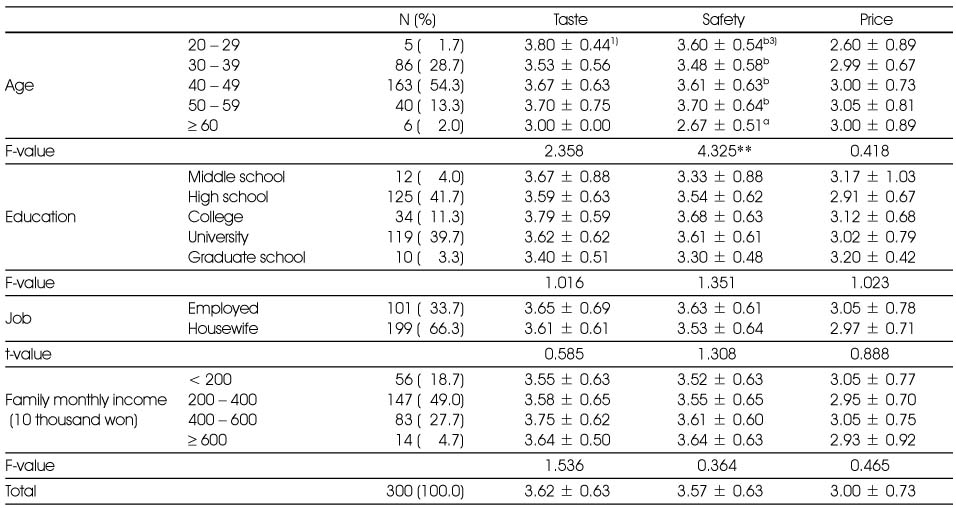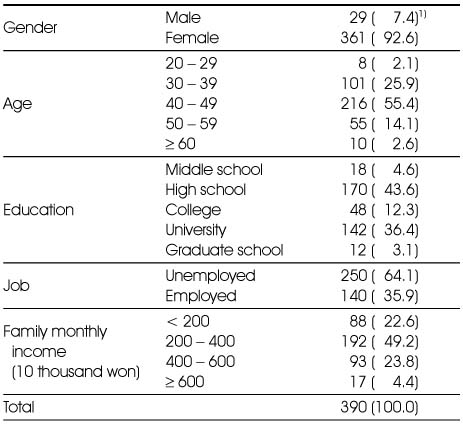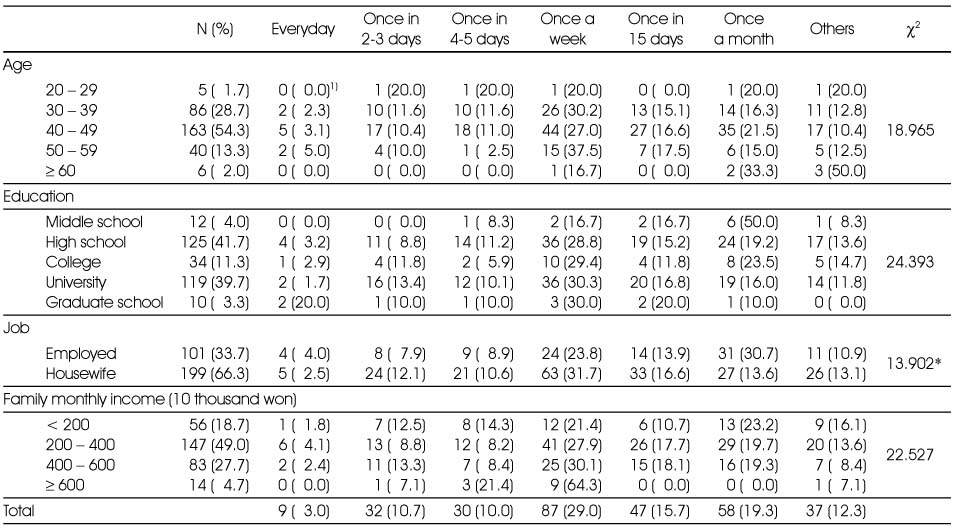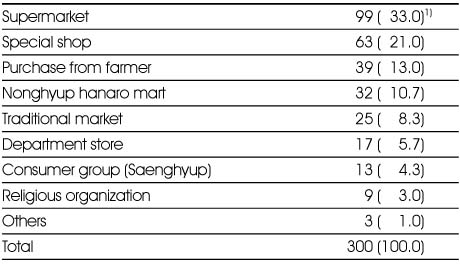Articles
- Page Path
- HOME > Korean J Community Nutr > Volume 16(3); 2011 > Article
-
Original Article
- The Housewives' Purchase Behaviors on Environment-friendly Agricultural Products in Daejeon Area
- In-Jung Kim, Joon-Ho Lee
-
Korean Journal of Community Nutrition 2011;16(3):386-397.
DOI: https://doi.org/10.5720/kjcn.2011.16.3.386
Published online: June 30, 2011
Department of Consumers' Life Information, Chungnam National University, Daejeon, Korea.
- Corresponding author: Joon-Ho Lee, Department of Consumers' Life Information, Chungnam National University, 99 Daehangno, Yuseong-gu, Daejeon 305-764, Korea. Tel: (042) 821-6847, Fax: (042) 821-8887, joonho@cnu.ac.kr
Copyright © 2011 The Korean Society of Community Nutrition
- 1,028 Views
- 1 Download
- 8 Crossref
Abstract
- This study was to investigate the housewives' purchase behaviors on the environment-friendly agricultural products (EFAP) by survey in Daejeon area housewives. 390 questionnaires were used and analysed. Most of the subjects were female (92.6%) distributed evenly in their 40's (55.4%), and graduated from high school (43.6%) or college (36.4%). Subjects' occupation was most housewives (64.1%) and 77.4% of the subjects had monthly family income of 2 million won or more. 76.9% of the subjects had purchased EFAP already. The reason of purchasing EFAP was mainly "good for health" (80.3%), and reason for non-purchasing was "high prices" (28%) or "not so trustworthy" (25.6%). The most purchasing frequency was "once a week" (29%). 46.7% of the subjects spent 20% of their agricultural product cost for EFAP and 38.7% of them spent less than 30,000 won per month for EFAP. On checking of EFAP labeling, the housewives scored 3.59 for the validate date, 3.25 for the place of origin, 2.8 for the quality certification mark by 4-point Likert scale. 65.1% of the subject had intention to increase purchasing of EFAP in future. To promote the consumption of EFAP, the improvement factors were price-cutting (47.9%), trust on producers (18.2%) and quality betterment (17.7%). Accordingly, the consumers prefer EFAP for wellbeing health of families; however, they hesitate to buy due to their high price and the low reliability on producers of EFAP. Thus the producers and the related organization of EFAP should contrive proper countermeasures to increase consumer's satisfaction level on their credibility and price of EFAP.
- 1. An JH, Kang KO. Consumption type of housewives about organic and instant food. Korean J Food Nutr. 2006; 19(1): 28-37.
- 2. Choi HS, Chang GJ. The utilization of environment-friendly agricultural products of college students in Seoul and Incheon areas. Korean J Community Nutr. 2007; 12(6): 742-751.
- 3. Jang JK. A study on marketing promotion of environmentally friendly agricultural product. 2006; Graduate School of Agricultural Economics, Chonnam National University; 1-62 MS thesis.
- 4. Jeong EM. The development and characteristics of the environment-friendly agricultural policy in Korea. Korean J Org Agric. 2006; 14(2): 117-137.
- 5. Kim CK, Jung HK, Moon DH. Recent production status and market prospect of environmentally friendly agricultural products in domestic and foreign countries. Report on Agricultural Research. 2009; Seoul: Korea Rural Economic Institute; 58.
- 6. Kim CK, Lee YS, Lee SG. Consumer's attitudes and marketing strategies for environmentally friendly agricultural products. Policy Analysis. 2008a; Seoul: Korea Rural Economic Institute; 98.
- 7. Kim IH. The effect of health concern on purchase behavior of the environmental friendly agricultural products. 2010a; Graduate School of Public Administration, Hanseo University; 16-17 MS thesis.
- 8. Kim JW. The effect of consumer knowledge and attitude about environment-friendly agricultural products on the purchasing behavior for those products. 2010b; Graduate School of Education, Ulsan University; 28-29 MS thesis.
- 9. Kim JY. A study on the distribution structure of organic farming products for environmentally sustainable agriculture. 2001; Graduate School of Urban and Regional Planning. Dankook University; 1-81 MS thesis.
- 10. Kim KD, Lee JY, Namkung S. Purchase behavior of environment-friendly agricultural products by housewives in Seoul area. J Korean Soc Food Sci Nutr. 2008b; 37(12): 1667-1673.Article
- 11. Kim NR, Cho YS, Kim SA. Satisfaction and recognition level of environment-friendly agricultural products in Cheongju area. Korean J Community Nutr. 2011; 16(1): 75-85.Article
- 12. Kim SH. A study on the marketing promotion of environmentally friendly agricultural products. 2009; Graduate School of Management, Mokpo National University; 1-73 MS thesis.
- 13. Kim SO, Kim MH, Shim JH. Understanding of consumers' perceptions on environment-friendly agricultural products (EAP) and purchasing behavior by comparing purchasers and nonpurchasers. Korean J Org Agric. 2008c; 16(1): 21-42.
- 14. Kim YS. A study on the utilization present status and the satisfaction with environment-friendly agricultural products. 2005; Graduate School of Traditional Culture and Arts, Sookmyung Women's University; 47-88 MS thesis.
- 15. Kim YT. A study on the efficient plan of improving environmental-friendly agriculture. 2006; Graduate School of Industry Kwangju University; 1-90 MS thesis.
- 16. Ko BS, Ko PS. The study on the characteristics of circulation of environmentally friendly agricultural products and the consumer's purchase intention. Korean J Culinary Res. 2005; 11(4): 214-227.
- 17. Lee HW, Yun JH. Studies on change of organic farming in Korea from 1907~2007. Korean J Org Agric. 2007; 15(4): 399-411.
- 18. Lee JS. An analysis of production on environmental friendly agriculture in Korea. Korean J Org Agric. 2002; 10: 29-50.
- 19. Lee JY. Analysis of consumer's behavior on the environment-friendly agricultural products. 2006; Graduate School of Agricultural Economics, Chungnam National University; 26-68 MS thesis.
- 20. National Agricultural Products Quality Management Service. 2010; cited 2010 February 1. Available from http://www.naqs.go.kr/serviceInfo/service_01_01.jsp.
- 21. The preferance analysis and demand forecast of consumers on environment-friendly agricultural products. 2005. 4. 12. Nongmin Newspaper. 2005; cited 2010 January 5. Available from http://www.nongmin.com/download/index.htm?mode=detail&no=938.
- 22. Park JY. A study on use status of and satisfaction with environmental-friendly agricultural products by female consumers in Jeju area. 2007; Graduate School of Education, Jeju National University; 37. MS thesis.
- 23. Park YE. An analysis on consumption behavior of environment-friendly agricultural products. 2002; Graduate School at Dong-A University; 32-34 MS thesis.
- 24. Shin CN. A survey on consumption pattern of environment-friendly agricultural products -with special reference to consumer in Changwon, Jinju and Sacheon area. 2006; Graduate School of Human Ecology and Environment, Kyungsang National University; 50-52 MS thesis.
- 25. Yang GS. Distribution conditions and marketing strategies for environmentally friendly agricultural products. The Journal of Korean Island. 2009; 21(1): 153-170.
REFERENCES


Figure & Data
REFERENCES
Citations

- Sustainability transitions in agri-food systems: insights from South Korea’s universal free, eco-friendly school lunch program
Jennifer E. Gaddis, June Jeon
Agriculture and Human Values.2020; 37(4): 1055. CrossRef - Perception of Use of Environment-friendly Agricultural Products during School Foodservice of Mothers of Elementary School Students in Gyeonggi
Young-Un An, Myung-Hee Kim, Mi-Kyeong Choi, Mi-Hyun Kim
Korean Journal of Community Nutrition.2018; 23(3): 234. CrossRef - Factors Influencing the Purchase Intention of Environment-Friendly Agricultural Products for Mothers with Elementary School Children
Xiang Li, Dong-Yean Park
The Korean Journal of Community Living Science.2018; 29(1): 97. CrossRef - Perception and Purchase Behavior on Environment-friendly Agricultural Products of College Students in Daejeon
Yu-Jin Cho, Nan-Sook Koo
Korean journal of food and cookery science.2015; 31(3): 328. CrossRef - Perception of School Foodservice Using of Environmentally Friendly Agricultural Products of Elementary School Parents in Jeonnam
Hee-Sook Cho, Kyung-Hee Kim
Journal of The Korean Society of Food Culture.2014; 29(6): 577. CrossRef - A Study of Food Habit and Food Purchase Behavior on Healthy Dietary Life by Housewives in Daejeon
Ji Hyun Yu, Nan Sook Koo
Korean Journal of Human Ecology.2013; 22(2): 375. CrossRef - Middle School Students' Perception of Environment-friendly Agricultural Products (EAPs) and the Degree of Confidence about the Certification Mark in Daegu
Ji-Yeon Jang, Mi-Kyung Choi
Korean Journal of Community Nutrition.2013; 18(4): 324. CrossRef - A Study on the Pattern of Consumption Behavior of Environmentally-friendly Agricultural Products by Housewives and an Assessment of the Need for Environmentally-friendly Agricultural Products in Childcare Centers in Jeonju
Jeong-Ok Rho, Hyun-Jin Kim
The Korean Journal of Food And Nutrition.2012; 25(2): 215. CrossRef
General characteristics of the subjects
1) N (%)
Purchased experience of environment-friendly agricultural products
1) N (%)
Reasons on purchasing environment-friendly agricultural products
1) N (%)
Reasons on non-purchasing environment-friendly agricultural products1)
1) Multiple response, 2) N (%)
(Total N = 90)
Purchasing frequencies of environment-friendly agricultural products
1) N (%), *: p < 0.05
Purchasing ratio of environment-friendly agricultural products among total agricultural products
1) N (%), *: p < 0.05
Purchasing cost of environment-friendly agricultural products per month (unit : Won)
1) N (%), **: p < 0.01, ***: p < 0.001
Purchasing frequencies of environment-friendly agricultural products's food groups
1) N (%)
Purchasing place of environment-friendly agricultural products
1) N (%)
Choosing factors of purchasing place1)
1) Multiple response, 2) N (%)
(Total N=300)
The most considerable factors on purchasing environment-friendly agricultural products
1) N (%) *: p < 0.05, ***: p < 0.001
The housewives' satisfaction on taste, safety and price of environment-friendly agricultural products2)
1) Mean ± SD, **: p < 0.01
2) 5 points Likert scale: 'Very satisfied' (5 points) ~ 'Very dissatisfied' (1 point)
3) Different superscripts in the same column mean significant differences among groups by Duncan's multiple range test (p < 0.05)
Checking on environment-friendly agricultural products labeling2)
1) Mean ± SD, *: p < 0.05, **: p < 0.01
2) 4 points Likert scale : 'Always check' (4 points) ~ 'Almost not check' (1 point)
3) Different superscripts in the same column mean significant differences among groups by Duncan's multiple range test (p < 0.05)
The purchasing intention of environment-friendly agricultural products at hereafter
1) N (%), **: p < 0.01
The improvement factors for consumption promotion of environment-friendly agricultural products
1) N (%)
1) N (%)
1) N (%)
1) N (%)
1) Multiple response, 2) N (%) (Total N = 90)
1) N (%), *: p < 0.05
1) N (%), *: p < 0.05
1) N (%), **: p < 0.01, ***: p < 0.001
1) N (%)
1) N (%)
1) Multiple response, 2) N (%) (Total N=300)
1) N (%) *: p < 0.05, ***: p < 0.001
1) Mean ± SD, **: p < 0.01 2) 5 points Likert scale: 'Very satisfied' (5 points) ~ 'Very dissatisfied' (1 point) 3) Different superscripts in the same column mean significant differences among groups by Duncan's multiple range test (p < 0.05)
1) Mean ± SD, *: p < 0.05, **: p < 0.01 2) 4 points Likert scale : 'Always check' (4 points) ~ 'Almost not check' (1 point) 3) Different superscripts in the same column mean significant differences among groups by Duncan's multiple range test (p < 0.05)
1) N (%), **: p < 0.01
1) N (%)

 KSCN
KSCN













 Cite
Cite


